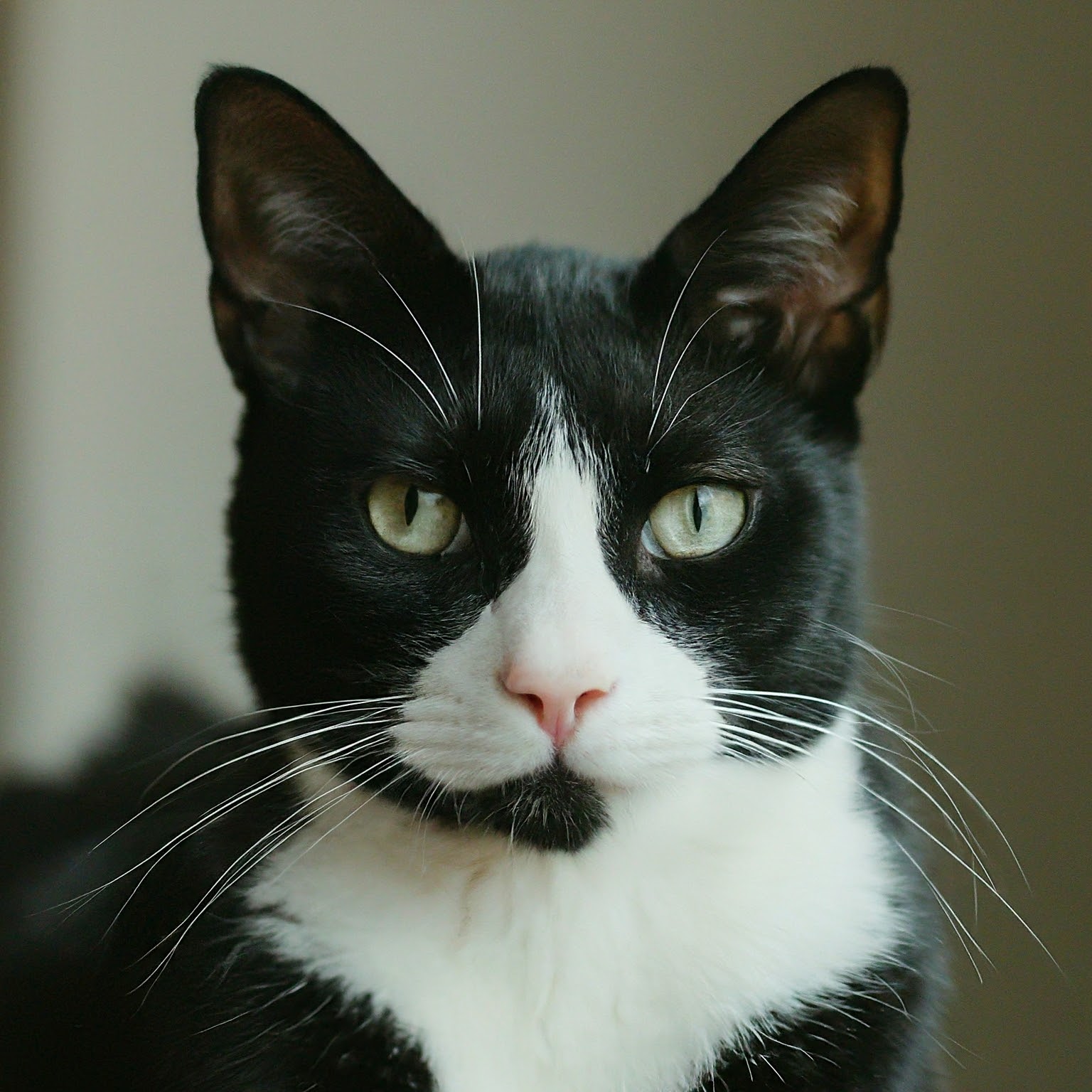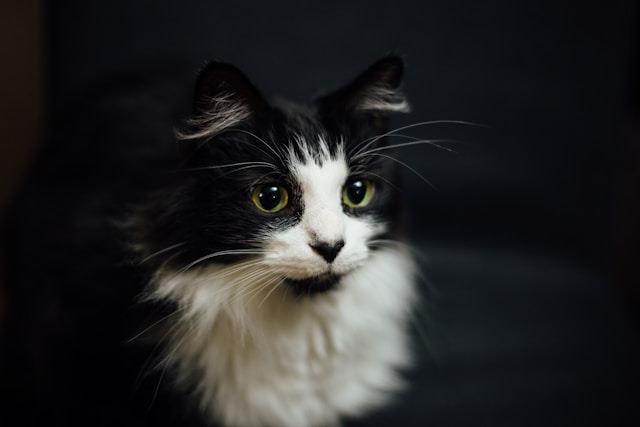
The tuxedo cats have a prominent black-and-white bicolor pattern reminiscent of men’s formal wear. Mixed-breed cats as well as some pure breeds may possess the tuxedo pattern.
Any combination of black-and-white in piebald style qualifies as a tuxedo cat, but the most striking examples have a black body with white chest and paws.
Sometimes, a black spot on the throat even resembles a bow tie!
Other names: Tuxie, Felix cat, Jellicle cat, Piebald
Personality: Varies with breed
Weight: Up to 18 pounds, depending on the breed
Length: Up to 36 inches from nose to tail, depending on the breed
Coat length: Short, long, or curly
Coat colors: Black and white
Coat patterns: Bicolor
Eye colors: Various shades of gold, green, or blue
Life expectancy: Up to 20 years
Hypoallergenic: No (Sphynx and Devon Rex breeds are less allergenic)
Origin: Ancient Egypt
Tuxedo Cat Characteristics
The tuxedo is a color pattern that can occur in many different breeds of cats. The tuxedo pattern gets its name from the formal attire worn by men on special occasions.
Nothing is as dramatic as seeing a “tuxie,” as it’s affectionately called, dressed in its best outfit. Some tuxies also wear “spats” or white boots. This name comes from the word “spatterdash,” which is a type of covering that goes over the instep and ankle area of some shoes.
Other variations on the tuxedo theme include a white-striped nose and the “masked tuxedo,” with white around the chin and nose or white tips on the nose. Another variation, infamously called “Kitler,” features a white “mustache.”
As many breeds and mixed breeds can display the tuxedo pattern, the personalities of tuxedo cats vary much more than their coloring. The individual cat’s temperament will depend on its genetics and the environment in which it was raised.
Tuxedo Cat History
Cats possess color genes that can produce the tuxedo pattern in the right combination. Tuxedo cats have the genes to be black. They also possess the gene for white spotting, which masks the black color on some parts of the body.
No one knows for sure when this combination of genes began to be expressed in cats, but it is believed to date back at least to ancient Egypt, as bicolor cats were identified in their tombs. Tuxedo cats appear throughout modern popular culture. Examples of famous bicolor kittens include:
Felix the Cat was a character created during the silent film era of the 1920s. Felix was featured in cartoons, animations, and various merchandise. To this day, Felix’s clock, with its long black tail swinging back and forth, is a favorite cat collectible.
In T.S. Eliot’s 1939 book of poems, “Old Possum’s Book of Practical Cats,” a group of black-and-white nocturnal cats was referred to as “Jellicle” cats.
Sylvester the Cat, from Looney Tunes, is another famous tuxedo cat. Sylvester has white cheeks, a long bib extending to the belly, white feet, and a white tip on the tail.
Dr. Seuss’s “The Cat in the Hat,” published in 1957, also featured a talking tuxedo cat.

Appearance
You’ll know if a cat has the tuxedo pattern from birth. Kittens are simply miniature versions of the adult pattern, rather than having a color pattern that changes as they grow.
These black and white beauties come in all shapes and sizes but always seem a bit more sophisticated than their counterparts because of their neat tuxedo markings.
While gray cats may have a similar bicolor pattern, they’re generally not considered tuxedo cats.
Tuxedo Cat Care
The individualized care of a tuxedo cat will depend on its breed. Their fur doesn’t require special treatment based on the color pattern. Brushing your cat will help reduce mats and may help prevent hairballs.
Trim your cat’s nails every two to three weeks and provide a scratching post. Additionally, like with any cat, stay up to date with vet visits and vaccinations to help prevent health problems.
Give your cat plenty of opportunities to play and chase toys, and offer safe places to retreat. Cats enjoy sleeping a lot and taking naps, so provide a comfortable bed and other spots around your living area where your cat can rest.
Indoor cats will need a litter box in a quiet area. Be sure to completely empty and clean the box at least once a week. Using clumping litter and scooping clumps daily can keep things tidy.
Common Health Issues
Tuxedo cats can be of many different breeds, some of which are more prone to specific diseases and conditions. The ASPCA lists these common cat illnesses as ones you’ll need to be aware of for any cat:
- Cancer: Cancer is more common in older cats.
- Diabetes: This is more common in obese, male, and older cats.
- Kidney Disease: A common problem in older cats, kidney disease can lead to organ failure.
- Hyperthyroidism: Overactive thyroid glands are also extremely common in cats.
Diet and Nutrition
Your tuxedo cat should be fed the same diet as any other cat of the same breed. While it may be dressed impeccably, your cat doesn’t need a caviar dinner.
A diet of wet food is often considered best, but you can also provide dry food for your cat to nibble on. Discuss your cat’s needs with your vet, especially if your cat has diabetes, is obese, or is senior.
Where to Adopt or Buy a Tuxedo Cat
Mixed-breed tuxedo cats are quite common and can be found in adoption shelters, but pure breeds featuring the black-and-white pattern should be obtained through breeders.
Here is a list of some rescues that may have tuxedo cats:
Breed Overview
Maybe you’re looking for a shelter cat with bold colors or a specific black-and-white breed—or perhaps you’ve found a lost kitten that seems to be wearing a formal suit.
Regardless of lineage, you likely won’t be able to resist the charm of a tuxedo cat.
It may have short or long fur, be male or female, and have a surprising personality, but one thing is for sure: a tuxedo cat is far from ordinary.
- Charming pattern resembling a tuxedo
- Almost any cat can possess the pattern
- Various breeds accept the pattern
- Cannot be bred for particular markings
- Personality traits vary
